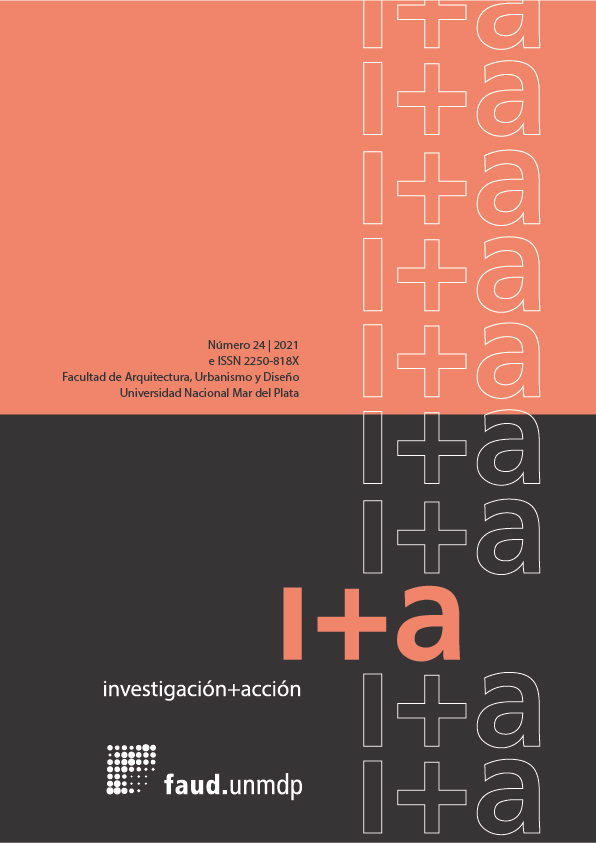Bioclimatic characterization of Mar del Plata.
Recommendations for architectural design
Abstract
With the exponential increase in the population on Earth, there is a concern for the sustainability of architecture as an item that consumes a great deal of non-renewable energy. Today, caused by the SARS-CoV-2 pandemic, it is compounded by imperative needs for comfort and health.
Bioclimatic architecture uses and optimizes natural resources to improve living conditions, reduce energy costs and reduce environmental impact. The objective of this work is to analyze the bioclimatic conditions in the Mar del Plata region to facilitate decision-making for the design of buildings.
The methodology consists of the study of several central themes: climate, comfort, shape, sunlight and wind, based on data from the National Meteorological Service. Simultaneously, the IRAM 11603 standard and the reference bibliography are taken into account.
The results obtained indicate that the constructions in the region should respond to a predominantly cold and humid climate. The architecture would have to maintain a certain compactness, use thermal insulation, have good orientation to take advantage of the sun in the cold months, provide good ventilation and protect itself from the winds.
Downloads
References
Acosta, W. (1976). Arquitectura y clima. Buenos Aires: Nueva Visión.
Bardou, P. y Arzumania, V. (1981). Sol y arquitectura. Barcelona: Editorial GG.
Czajkowski, J.D. y Gómez, A.F. (2002). Diseño bioclimático y economía energética edilicia. Fundamentos y métodos. La Plata: Universidad Nacional de La Plata.
Energy Design Tools Group (2019). Climate Consultant [Software de computadora]. Los Angeles: UCLA.
Evans, J. M. y de Schiller S. (1994). Diseño bioambiental y arquitectura solar. Buenos Aires: Editorial EUDEBA.
García, M. C. (2013). Clima urbano costero: Mar del Plata y Necochea-Quequén (Tesis doctoral). GAEA, Buenos Aires.
Gonzalo, G. E. (2015). Manual de arquitectura bioclimática y sustentable. Buenos Aires: Nobuko.
Gonzalo, G. E. (2000). Programa para la graficación de frecuencias y velocidad de vientos en una localidad [Software de computadora]. Tucumán: CEEMA, IAA, FAU, UNT.
Grossi Gallegos, H y Righini, R. (2007). Atlas de la energía solar de la República Argentina. Buenos Aires: ASADES.
Izard, J. y Guyot, A. (1983). Arquitectura bioclimática. Distrito Federal: Editorial GG.
Le Corbusier (1955). El poema del ángulo recto. Recuperado de: https://art1arquitectura.blogspot.com/2010/11/el-poema-de-angulo-recto.html.
Neila González, J.F. (2004). Arquitectura bioclimática en un entorno sostenible. Madrid: Munillalería.
Norma IRAM 11603 (2011). Acondicionamiento térmico de edificios. Clasificación bioambiental de la República Argentina.
Thorpe, D. (2018). Passive solar architecture pocket reference. Londres y Nueva York: Routledge.
Ventura, D. BBC News Mundo. (10.05.2020). Coronavirus: cómo las pandemias modificaron la arquitectura y qué cambiará en nuestras ciudades después del covid-19. Recuperado de: https://www.bbc.com/mundo/noticias-52314537.
Downloads
Published
How to Cite
Issue
Section
License
Copyright (c) 2021 Investigación + Acción

This work is licensed under a Creative Commons Attribution 4.0 International License.
Aquellos autores/as que tengan publicaciones con esta revista, aceptan los términos siguientes:
- Los autores ceden a Revista I+A de forma gratuita y no exclusiva, los derechos de reproducción, distribución y comunicación pública de su obra, autorizando asimismo su inclusión en la revista digital; su transformación, siempre que sea necesaria para permitir su preservación y uso en formato electrónico, así como para la incorporación de sistemas de seguridad y/o identificación de procedencia y el almacenamiento en servidores institucionales
- La obra estará sujeta a la Licencia de reconocimiento de Creative Commons BY, que permite a terceros compartir la obra indicando su autor y su primera publicación esta revista.
- El/los autor/es podrá/n adoptar otros acuerdos de licencia no exclusiva de distribución de la versión de la obra publicada (p. ej.: depositarla en un archivo telemático institucional o publicarla en un volumen monográfico) siempre que se indique la publicación inicial en esta revista.
- Se permite y recomienda a los autores/as difundir su obra, tanto en sus sitios web personales, en repositorios institucionales o temáticos en cualquier versión: pre-print, post print o el archivo pdf publicado en la revista, respetando la licencia de uso Creative Commons Atribución 4.0 otorgada por la revista
- El/los autor/es deberá/n declarar la originalidad del material y transferir los derechos para la publicación. No se pagarán derechos de autor.





